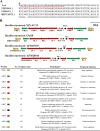Toyoncin, a Novel Leaderless Bacteriocin That Is Produced by Bacillus toyonensis XIN-YC13 and Specifically Targets B. cereus and Listeria monocytogenes
- PMID: 33811023
- PMCID: PMC8174769
- DOI: 10.1128/AEM.00185-21
Toyoncin, a Novel Leaderless Bacteriocin That Is Produced by Bacillus toyonensis XIN-YC13 and Specifically Targets B. cereus and Listeria monocytogenes
Abstract
Bacteriocins have attracted increasing interest because of their potential as natural preservatives. Recent studies showed that the Bacillus cereus group is a prominent producer of bacteriocins. Using a laboratory-based screening strategy, we identified a strain in the B. cereus group, Bacillus toyonensis XIN-YC13, with antimicrobial activity against B. cereus. A novel, 70-amino-acid-long leaderless bacteriocin, toyoncin, was purified from the culture supernatant of strain XIN-YC13, and its molecular mass was found to be 7,817.1012 Da. Toyoncin shares no similarity with any other known bacteriocins, and its N-terminal amino acid is formylmethionine rather than methionine. Toyoncin shows good pH and heat stability and exhibits specific antimicrobial activity against two important foodborne pathogens, B. cereus and Listeria monocytogenes. Additionally, toyoncin exerts bactericidal activity and induces cell membrane damage. Toyoncin can also inhibit the outgrowth of B. cereus spores. Preservation assays showed that toyoncin effectively suppressed or eradicated B. cereus and L. monocytogenes in pasteurized skim milk. These results suggest that toyoncin can be used as a new biopreservative against B. cereus and L. monocytogenes in the food industry. IMPORTANCE We identified a novel leaderless bacteriocin, toyoncin, produced by B. toyonensis XIN-YC13. Toyoncin shows good pH and heat stability, and it has specific antimicrobial activity against B. cereus and L. monocytogenes (two important foodborne pathogens), likely by destroying their cell membrane integrity. Toyoncin inhibited the outgrowth of B. cereus spores and effectively inhibited or eliminated B. cereus and L. monocytogenes in a milk model system. These results indicate the potential of toyoncin as a food preservative.
Keywords: Bacillus toyonensis; bacteriocin; food preservatives; toyoncin.
Figures







References
-
- Hemalata VB, Virupakshaiah DBM. 2016. Isolation and identification of food borne pathogens from spoiled food samples. Int J Curr Microbiol Appl Sci 5:1017–1025. 10.20546/ijcmas.2016.506.108. - DOI
-
- Delesa DA. 2017. Bacteriocin as an advanced technology in food industry. Int J Adv Res Biol Sci 4:178–190. 10.22192/ijarbs.2017.04.12.018. - DOI
-
- Flynn K, Villarreal BP, Barranco A, Belc N, Björnsdóttir B, Fusco V, Rainieri S, Smaradóttir SE, Smeu I, Teixeira P, Jörundsdóttir HÓ. 2019. An introduction to current food safety needs. Trends Food Sci Technol 84:1–3. 10.1016/j.tifs.2018.09.012. - DOI
Publication types
MeSH terms
Substances
Supplementary concepts
LinkOut - more resources
Full Text Sources
Other Literature Sources
Molecular Biology Databases

